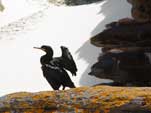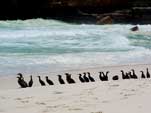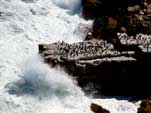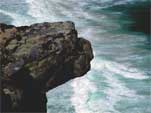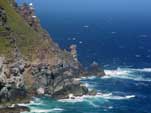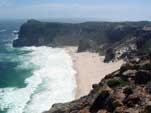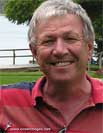 From the editor: Human relations, indigenous/alien projects … hopefully many South Africans of all races will read this fairytale on the Hottentots-god.
From the editor: Human relations, indigenous/alien projects … hopefully many South Africans of all races will read this fairytale on the Hottentots-god.
When listening to the wheeling and dealing on bushmen crafts of when and where and .… in short all the other questions starting with a “w” describing the creation of their products, I asked as well “what about a fairytale-like story, a story may be told by a bushman or San when sitting around a fireplace while listening to the sound of the night?
“Yes, no problem, I will do that!”
The same day, a couple of hours later, Henry Jansen, alias Xam, a trader from Namibia, left Hout Bay for an appointment in Franschhoek. From there he organised somebody to capture the tale on a computer. A couple of minutes later I received an email in Afrikaans and a SMS asking if the language would cause a problem. Of course not, my daughter translated and so the story goes:
The Hottentots-god
by Henry Jansen alias Xam

Henry Jansen
|
One day all the animals got together and decided to destroy the one; namely the Hottentots-god. He was too fine and small, and usually sat in every tree and bush for days on end and never did anything. Elephants flattened every tree to get rid of the Hottentots-god. Lion roared that the earth shook and even the hyena lifted its last leg. Then a big drought arrived and everyone started to suffer, as there was no rain to feed the plants or the animals. Then they realized that the Hottentots-god always prayed for rain, but by then it was too late…..
[Let there be a place for everyone under the sun – and everyone to take their lawful place – even the bushman to tame nature and to dance for the rain.]
As I feel this has to be the original version -> the original Afrikaans version composed by Henry:
Eendag het die diere bymekaar gekom en besluit om die een dier uit te wis; naamlik die hottentotsgod. Hy was te fyn en klein en het gewoonlik in elke boom of bos gesit en sit vir dae sonder om iets te doen. Olifant het elke boom plat geloop om hottentotsgod te verbrysel. Leeu het gebrul dat die aarde sidder en selfs hyena het sy laaste beentjies opgetel. Toe kom daar n baie groot droogte en almal het begin ly,want daar was geen reen om plant en dier te voed. Toe het hulle besef hottentotsgod het altyd gebid vir reen,maar dit was reeds te laat...
Deur Henry Jansen alias Xam
[Laat daar vir elkeen n plekkie in die son wees en elkeen sy regmatige plek in neem,selfs die boesman om die natuur te tem en te dans vir reen.]
|

The Cape Film Commission at Sithengi
|
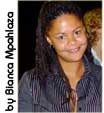
|
|
23 November 2006. It’s been an amazing Sithengi Market and Cape Town World Cinema Festival- and the CFC was there to support it every step of the way.
As per usual, the CFC was available at its very prominent stand to provide any information on filming in the Western Cape, as well as showing off some of the great product currently being produced by Capetonians both in print and film.
We were honoured to host a fantastic Japanese Delegation, which has resulted in a deal for a featurette to be shot in Cape Town during 2007 and over 4 products being bought by Japanese Distributors. The SA Embassy in Tokyo has also again confirmed their commitment to the “Cape Town to Tokyo” film festival, which was very successfully held for the first time this year in September, in Tokyo. The CFC also hosted Delegations from the UK, LA and Norway, including Andrew Deane of “Requiem for a Dream” fame.
But that’s not where it ended! The CFC facilitated the outreach programs on behalf of Sithengi this year in Mitchell’s Plein, Nyanga and Gugulethu in the furtherance of its audience and skills development strategy with great success! The Outreach program this year included a mini Hip Hop festival in Mitchell’s Plein, and SABC’s broadcast of Gospel Gold in Gugulethu- ensuring maximum attendance at both venues, and ensuring that The Cape Town World Cinema Festival and its great films reach as many citizens as possible! Bunny Chow was the Premier at all venues, and new to the event was a shorts section which proved immensely popular.
And then there was the opening of the Market itself- a very exciting occasion hosted by the CFC on behalf of the MEC Essop and Premier Rasool, who wanted to ensure that visitors, distributors, delegates and film professionals know that Cape Town and the Western Cape is a home for Film. Labelled as one of the best events of the week, the networking function ensured that Internationals in particular could find out about film in the Western Cape.
The CFC is currently hard at work preparing for 2007, and we look forward to sharing our plans for this year with the industry very shortly!!
|
|
|
|
'Do not look where you fell, but where you slipped'
|
 |
'Getting things fixed – a resolve by the disabled' |
|
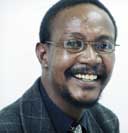
|
There are concerns by the disabled community that treatment that is being meted out to them subjects them to being lesser citizens of society. The question is how did we get to that point? A proverb of the Vai people of Liberia advises how to determine the source of displeasure: "Do not look where you fell, but where you slipped."
Writes: Edwin Sipho Rihlamvu
Disability is a multi-faceted institution in our society and indeed a global village player. As a disabled community, we recognize the role that we have to play in the economic threshold of the country and in its social transformation.
This because we have overcome the state of denial and accept that sitting on the margin or in the periphery – moaning groaning, throwing tantrums and sour grapes - is not the answer to social cohesion and integration that we so desperately aspire for. We have learnt to take a good look at ourselves – we have learnt to laugh at ourselves!
One of my friends who has just returned from the US tells me there’s a garage not far from Washington, which advertises its services in a striking way! The owner has hoisted a seriously wrecked Volkswagen beetle on the top of a telephone pole and on the side of the beetle; he has painted the words - We Fix. The shop lives up to its motto. Its mechanics do tough jobs well!
Therefore, if we’re sometimes a little testy with each other [as a disabled community], it’s because we’re impatient with those of us whose sole contribution is to moan about what’s wrong. But we’ve got lots of time for people who are ready to work on the practicalities of getting things fixed.
'Being truly African'
In May 1996 at the adoption by the Constitutional Assembly of The Republic of South Africa Constitution Bill, President Thabo Mbeki made ground – breaking comments when he delivered his now world renowned “I am an African” speech. But perhaps more profoundly, was his unwavering recognition that there are still ills that afflict our society that we have to recognize and vehemently seek to uproot with determined energy, vigor and resolve before they slow the fabric of this our budding democracy.
Among other tantalizing expressions the President said “I have seen what happens when one person has superiority of force over another, when the stronger appropriate to themselves the prerogative even to annul the injunction that God created all men and women in His image”. I strongly believe that over and above race issues, the President was impressing upon us the danger of inflicting pain on others by visiting the state of their physical being and classifying them as lesser mortals.
In this regard, as we come to the end of a gruelling year, which served us with dishes of challenges, celebrations, hardships, joy, pain, sorrow etc, perhaps our collective voice should be found in the unassuming challenges posed by the President when he said:
“I have seen concrete expression of the denial of the dignity of a human being emanating from the conscious, systemic and systematic oppressive and repressive activities of other human beings. All this I know and know to be true because I am an African!”
We are collectively aware of these challenges and I suggest that our resolve be to know that disability has the corner in South Africa and we are increasingly seeking your partnership to turn the tide and emerge a triumphant African people!
The disabled community is aware that great masses that are our mother and father will not permit that the behaviour of the few results in the description of our country and people as not being tolerate of disability. Patient because history is on their side, these masses do not despair because today the weather is bad. Nor do they turn triumphalist when, tomorrow, the sun shines.
But this call also constitutes a tribute to our loss of vanity that we could, despite the temptation to treat ourselves as an exceptional fragment of humanity, draw on the accumulated experience and wisdom of all humankind, to define for ourselves what we want to be.
Together with the best in the world, we too are prone to pettiness, petulance, selfishness and short-sightedness. But it seems to have happened that we looked at ourselves and said the time had come that we make a super-human effort to be other than human, to respond to the call to create for ourselves a glorious future, to remind ourselves of the Latin saying: Gloria est consequenda - Glory must be sought after!
'Beginning the Fixing'
The 1st of December falls within the period of the 16 Days of No Violence Against Women and Children and therefore we must also speak out loud against the prevalent abuse of disabled women and children in particular.
There is a lot of abuse that disabled women and children suffer, even to the extent of children with mental disabilities being chained and locked up in backyard houses. We cannot keep quiet when we know these things are happening in our communities. We need to expose these horrible deeds and in that way we can be proud that we are indeed making a contribution in acting against the abuse of disabled women and children.
There is an important principle of self-representation that should be at the center of all psychology involving people with disabilities. It is this principle that also translates in a very powerful way to the slogan of the South African disability rights movement, which says “Nothing about us without us”. This is about the self worth and dignity for people with disabilities.
We have challenges in this country, serious ones. They are part of the South African story. We must never deny it. In a very important way, they are part of what of makes our story great. You see, what makes South Africa the amazing place it is the extraordinary capacity of our people to meet challenges head on and find solutions. Government, business, civil society organizations, state-owned enterprises, faith-based organizations and the media are all participating in the drive to increase awareness of the negative impact of violence and abuse on women, children and on issues around disability.
'Finding Solutions'
South Africans have established a terrific track record of fixing what others have written off as terminally broken and of finding solutions where others have despaired. As a disabled community, together we decided that in the search for a solution to our problems, nobody should be demonized or excluded. We agreed that everybody should become part of the solution, whatever the might have done or represented in the past.
I wish everyone would drop, once and for all, the word miracle from the lexicon of descriptions for this country's achievements. It reeks of low expectations. And it misses the point. South Africans are not miracle people. We’re quite ordinary human beings with an extraordinary diversity of knowledge, wisdom and talent, who makes things work.
'Doing difficult things well'
We are today a tolerant and stable society because everyone came away feeling ownership in the result. And we have a strong economy because our leaders knew how to realize the ambitious social agenda we set for ourselves in the constitution, we would have to create the wealth to pay for it. And what helped us create the wealth? Peace, stability and many rights that are just as secure as they are internationally.
But more needs to be done. Changing laws can be swift, but giving them effect, and changing the mindsets that often render them ineffective, is a much more demanding task. We need to actively advocate for areas around access to amenities, tourism attractions, transport infrastructure and employment opportunities for the disabled – amongst others.
South Africans need to close the gap between the "rhetoric” and the "reality on the ground". Perhaps the modest question that we should all be asking ourselves before we do the fixing is –
'WHERE DID WE SLIP'
|
|
Cape Town Tourism and the Hout Bay Neighbourhood Watch (HBNW)
|
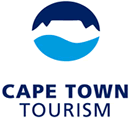
|
|
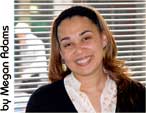
|
The safety of our visitors is essential! This was made clear at a recent safety meeting in Hout Bay, lead by the Hout Bay Neighbourhood Watch (HBNW).
The Hout Bay Community is pro-actively involved in “Project Visitor Safety” and they are claiming their village back from all criminals and are working inline with Cape Town Tourism and the Department of Economic Development & Tourism’s initiatives to ensure that tourism product owners are actively involved in providing practical advice to their guests when visiting Cape Town.
In September 2006, the South African Police Services (SAPS) released its National report that contact crime showed significant decreases.
Crime prevention in South Africa is based on the principles of community policing, meaning partnerships between the community and the SAPS, which strengthen existing community police forums.
We are expecting a bumper season – as it has been difficult to find empty accommodation establishments in Hout Bay and we therefore want to ensure that our guests will have a safe and superb holiday in one of South Africa’s most attractive seaside resort towns.
The credit card size Visitor Safety Tips card – “We Welcome, We Care” are available at the Cape Town Tourism: Hout Bay office;
|
|
In-Situ  The Migration Process From An Informal Settlement To Formal Housing
The Migration Process From An Informal Settlement To Formal Housing
|
Hout Bay
Civic Association |
|

Councillor
Dan Plato |
 Cape Town Mayor
Cape Town Mayor
Helen Zille
|
Sixteen years ago was the last housing development in Hangberg fishing village in Hout Bay and as a result the living conditions became worst and people lived in unexplainable conditions. There were no proper sewerage, electricity and water services and over the years the City of Cape Town provided these basic services to the community after immense pressure from Hout Bay Civic Associations (previously Hout Bay Action Committee).
HBCA have been engaging the City for the last three years to come up with a solution for the more than 500 informal houses in the area.
Tonight 27 November 2006 at Hangberg Civic Centre 18H30 Cape Town Mayor, Mrs Helen Zille, Councillor Dan Plato, Mayoral Committee member for Housing and Mr. Basil Davidson, City of Cape Town Head of Land would address the Hangberg community on the upgrading of the Hangberg informal settlement.

A concerned
Timothy Jacobs
|
Mr. Timothy Jacobs, chairperson the Hout Bay Civic Association says, “They fully support the proposed in-situ development, a development that should have been implemented years ago.
They appeal to all residents that if we need to make this a success that no additional informal structures should be erected because it could have a negative effect on the in-situ development.
Furthermore, that the timber frame structures that the City intends to build in Hangberg should have similar building regulations as Clifton, in order to a uniform architectural theme.
The first step should be formal addresses and title deeds to the current occupants in the informal houses.
If the title deeds are achieved HBCA could approach the banks and other financial institutions for financial assistance and owners can offer the property for security. This is only achievable if the National, Provincial and Local government allows in-situ development with property title.”
Mr. Jacobs said there may be a problem for banks to give loans if there is a time limit on the sale of the property in the event of loan default i.e. if the owners can’t sell for say 5 years, then the bank cannot get its money back for 5 years if there is a default.
We would want to ensure that Gentrification does not take place in the Secondary Housing Sales, which would lead to a break-up of the proud Hangberg Community Heritage. A mechanism is needed so that Sellers offer to a Hangberg resident or an approved relative of a resident. If no resident or relative is interested then the property should be sold to a Trust, which would warehouse the property until an approved buyer comes along.
Mr. Jacobs continues, “ broad-based economic empowerment and job creation of our historical disadvantaged fishing community is priority for this development and the development should allow for the automatic zoning of B&B’s, restaurants, coffee- shops and retail trade which should include the involvement of the Hout Black Business Opportunities Forum (HBBOF).”
The plan would include a one-way road between the informal houses and at the bottom of Sentinel mountain with parking bays for Hangberg property owners, visitors alike and emergency services.
Mr. Jacobs explains that, “Clifton is very popular and very expensive even without allocated parking on Victoria Road so the proposed parking will be very good for Hangberg timber homes values. We need as much parking for residents and tourists. Poor parking considerations will lead to parking chaos like in Clifton and Camps Bay in summer. The road at the top should be a scenic drive to draw tourists through Hangberg.”

Gregg Louw
|
Mr. Gregg Louw the Chief Executive Officer of HBBOF says, “The in-situ development is not a short term solution but a plan for 2010 and far beyond. Tourists would visit Hangberg if the village were a tourist friendly and orientated to the attractions of a Cape Fishing Village. HBBOF members in the tourism sector are launching a website to promote Hangberg in the month of December 2006. This we would discuss with the Western Cape Minister of Tourism, MEC Lynne Brown at HBCA’s newsletter, Hout Bay Speaks, fundraising on Friday 1 December and also with the City’s Tourism Directorate, Cape Town Routes Unlimited and Cape Town Tourism. Hangberg residents interested in community based tourism have attended three City of Cape Town workshops on community based tourism so far and this need to continue.”
Mr. Jacobs said that it is all bout responsible tourism and having recently completed a responsible tourism course under a partnership of the Cape Peninsula University of Technology, Western Cape Tourism Department and the International Centre for Responsible Tourism he is very excited.
This could be a major step of a community, government and private sector partnership.
Tourism would be implemented in a responsible way to create a competitive advantage for the promotion of balanced and sustainable tourism and focus on the development of environmentally based tourism.
This would be an investment and respect of the people of Hangberg’s culture and heritage and protect it from over commercialisation and over exploitation.
“A home is a womb of hope”, ended Mr. Jacobs.
Monday 27 November 2006
At the community meeting on Monday 27 November 2006, City of Cape Town Mayor, Mrs. Hellen Zille told the residents from Hangberg that this a pilot project and if it succeeds than the rest of South Africa can learn from it.
The importance would be that the community are united and petty issues should not be used to derail the process.
She stated that the view and the location of the area are so magnificent and people would do anything to stay here. The community have something to be proud of.
Councillor Dan Plato, City of Cape Town Mayoral Committee Member responsible for Housing informed residents that the Mayor, himself and the community leaders, Development Action Group and City officials on the Development Committee would meet every quarter to discuss the progress and report back to the community.
The first application for development would be submitted at the end of January 2007.
The first Development Committee meeting would take place in the week of 6 December 2006.
|
|
Department of Economic Development and Tourism
Welcome Awards 2007 |
 |
Recognising Service Excellence In Tourism |
|
30 November 2006
Grand West Market Hall, Grand West Casino
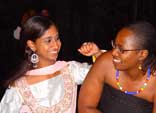 From left:
From left:
Farhaana Allie
Noxolo Ntenetya
|
 From left:
From left:
Brent Walters
Enver Mally
Noxolo Ntenetya
Lynn Maggot |
This is an initiative launched by Minister of Environmental Affairs and Tourism; Mr Marthinus van Schalkwyk at Tourism Indaba in 2005 and already had successfully announced winners at Indaba 2006. The project aims to find the shining examples of businesses and individuals in South Africa who are raising the level and standards of customer service in the tourism industry.
The Welcome Awards are presented in four categories:
- Accommodation
- Tour operators
- Tour guides
- Travel agents
On Thursday, 30 November 2006, The Western Cape Provincial Department of Economic Development and Tourism will be announcing the Three Provincial Welcome Award Winners 2007 for the Tourist Guide Category. Entries for the awards were received from registered tourist guides and the judges looked for the following:
- has to be successful in adding value to the customer experience
- must be committed to excellence in serving customers
- actively develop skills in their employees to improve visitor experience and not only provided service of a world class standard
- have exceeded expectations and turn their clients into ambassadors for South Africa
The Three Provincial winners will be entered into the National Competition to compete with other tourist guides from other provinces. A finalist from the Province will be chosen following a mystery tourist programme. The overall winner who has demonstrated most innovative, inspiring case study of a world class visitor experience will be announced at the Tourism Indaba 2007 and will receive a Grand Prix Award.
|
|
The Hidden Gem of Hout Bay
|
 |
Hout Bay Museum |
|
by Jonathan Dreyer
Many people are unaware of the fascinating wealth of memories and information of Hout Bay’s past, to be found in the charming cottage Museum, hidden away in a fynbos garden setting on Andrews Road, just off Main Road behind the Shell Garage.
The Museum was started in 1978, by a group of enthusiastic people who were concerned about the rapid development of the village and with it, the disappearance of things, which had been part of Hout Bay for so long. With a newly painted cottage and Pam Wormser as the Curator, articles from the days gone by, began to roll in and with the help of lots of ‘Friends’, the history of Hout Bay was saved for the generations to come.
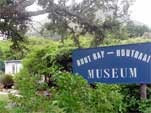
Hout Bay Museum
|
The Museum is beautifully laid out and one can spend many happy hours finding out where Hout Bay came from and how it grew from a few farms and a Fort, into a thriving fishing village.
The Museum is well known for the activities which centre around it, from the Environmental Centre for the children, Fireside Chats in the winter, Sun-downer Evenings in summer and the Guided Walks every weekend, which take you out into the mountains and around the coast to learn more about where we live.
Whether you are a resident or a visitor, Hout Bay Museum is a place which will take you back in time and where you can browse through the records of our village. It is all there, tucked away in this cottage with its little indigenous garden.
|
|
Khoikhoin And Their Mode Of Living
|
 |
Hout Bay Museum |
|
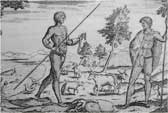 Sir James Lancaster in 1591
Sir James Lancaster in 1591
“We bought an ox for two knives, a sterke (calf) for a knife, and a sheepe for a knife; and some (animals) we bought for lesse value than a knife. The oxen be very large and well fleshed, but not fat. The sheepe are very big and very good meat; they have no woll on their backs, but haire, and great tailes …..” (some accounts describe the tails as being 24 inches in width).
Cornelius Matelief in 1608
“They are large folk, not quite Black, with curly hair, well made both of face and body, and very swift runners so that they can overtake a bull and catch him by the horns or the hind feet and so bring him to a standstill. Because of their greasing they can be smelt fully a rood down-wind ….. Around the body they have a leather thong, to which the tail of a fox or wild-cat is fastened just in front of their privities; and a cloak of a deer or buck skin ….. tied in front just below the chin, and reaching to the buttocks. Many also had dried guts around the neck ….. In one hand each bore a small stick as sick as a finger, and in the other a shor little stick over which the tail of a fox or a cat was drawn, wherewith they chased the flies from their body, this land being so full of flies that it is a marvel. They had shoes under the feet like driars use, but the soles somewhat wider than these. When they speak they cluck in their mouths at every second word, as when one clicks one’s fingers, so that their mouth sounds somewhat like a rattle, no sign of ships or shallops was seen among them.”
Sir Henry Middleton in 1604
“The negroes had their houses, which were no other than afew crocked sticks set in the ground and mattes cast over them ….”, when they want to move “….. they pull downe their houses and make them fast upon their beasts’ backes and drive away”.
Jean-Baptists Tavernier in 1649
“As regards meat, this they eat quite raw as also even fish. As to the guts (intestines) of the beasts, they press these between their fingers to remove the dung, and so eat them. The women commonly put these guts, when dry, around their legs; and especially the guts of such wild beasts as have been taken in the forests by their menfolk; and these serve them as an adornment. They also eat tortoises after they have laid them on the fire until they can take off their shells.”
|
|
West Coast Environmental Co-operative
|
Mural for Atlantis
October 2006 |
 |
Atlantis |
|
by Melvyn Miles
Public Relations Officer
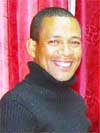 Melvyn Miles
Melvyn Miles
|
Chapter 28 of Agenda 21, a United Nations comprehensive plan to achieve sustainable development, urges local authorities to embrace the implementation of Agenda 21 by drawing up, along with their communities, their own LA21 (Local Agenda) plans to strengthen their contribution to global sustainable development.
The Atlantis Mural was done as part of The Local Agenda 21 Self sustainable Community Festival.
Last year a big mural was done in Khayaletsa and this year Manenberg , Elsies River and Atlantis also indicated their interest.
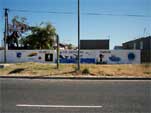 The Mural in Atlantis
The Mural in Atlantis |
The City of Cape Town made available R2500-00
The main criteria was that it (the wall) had to be City property and secondly that the theme had to compliment the festival.
The West Coast Environmental Co-operative spearheaded the project and identified a wall in the poorest community in Atlantis namely Mountview. After consulting with the Mountview Integrated Forum the local organizing body of the suburb were keen to join in. This would make sure that the residents took ownership of the project and the results.
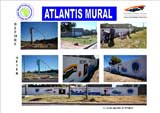 Atlantis Mural:
Atlantis Mural:
Before and After |
Two unemployed persons were employed to prepare the wall witch was in a bad condition and had to be plastered in some areas. This preparation took two days.
The artists were ten learners from the area from Saxonsea Secondary School where art is one of their subjects. This was under supervision of teacher Mr. Sacks who did the pencil layout as put together by project coordinator Melvyn Miles of the West Coast Environmental Co-operative.
The Theme “Atlantis for Sustainable Tourism” is reflecting on the fact that Atlantis has just been listed on the CAPE CARE Route as a tourism destination.
Big thanks to all involved:
City of Cape Town (Funding)
West Coast Environmental Co-operative (Implementer)
Mountview Integrated Forum
Saxonsea Secondary School (Artists)
Mr. Sacks (Supervisor)
Sydney Beukes and Chris (Preparation of wall and painting of structure)
Melvyn Miles (Project Coordinator)
|
|
|
 No. 014-01
No. 014-01
|
This Month Welcome Page
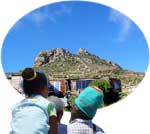 |
Please Diarise:
FACES OF THE CAPE
Exhibition of Photographs
by
Rudolf Rieger
at
Cape Town Tourism
Crn. Burg and Strand Street
Cape Town
Commencing
01 December 2006
 Exhibition Exhibition

FACE (IN) CAPE TOWN
Art Exhibition @ The Castle Of Good Hopee
featuring artists:
Alex Desole
Alfred Budaza
Ashar Mhlongo
Kate Smith
Vuyile Voyiya
Robert Robson
Ralph von Egidy
Selvin November
Shakes Tembani
Sophie Peters
Dathini Mzayiya
Vivien Kholer
Haidee Nel
Nico Eilers
Dion Cupido
Ernest Fulani
Unathi Sigenu
Toni Mhayi
Lizette Chirrime
incl.
Qubeka Group
Creative Block
AMAC students
15 Dec 2006 - 15 Jan 2007
|
|
Cultural Exchange Program
If somebody wants to know more about this or would like to become a sponsor of
On Set Images'
Cultural Exchange Project
please contact
 gallery@onsetimages.com gallery@onsetimages.com
| |
|
|
|
Distribution:
Our e-News are distributed to arts & culture, the film, stills & commercial industry, wildlife, heritage, companies servicing and attracting tourism ( tourist offices, travel agents, tourist guides & tour operators) locally and abroad as well as to people who have an interest in visiting South Africa.
© 2006 On Set Images. All rights reserved.
Published by

To ADVERTISE in this Newsletter
 news@onsetimages.com or call 021 790-2227 news@onsetimages.com or call 021 790-2227
Alternatively send us your CONTACT INFORMATION
Print Newsletter (note: set to landscape format) 
|
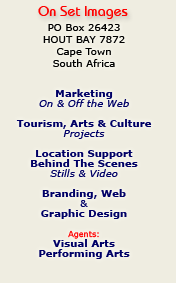
|
|





































